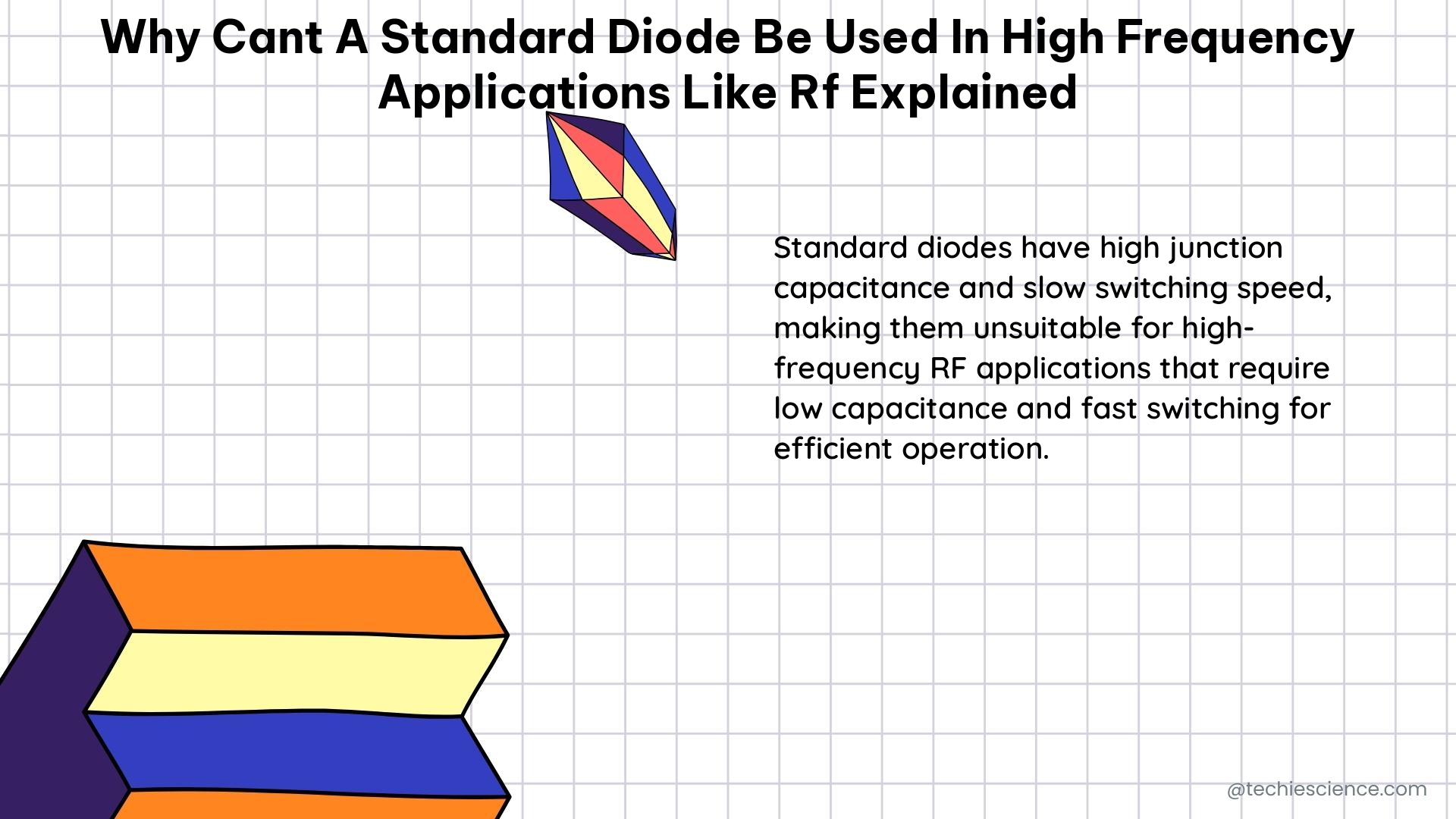Standard diodes, also known as PN junction diodes or general-purpose diodes, are not suitable for high-frequency applications like RF (Radio Frequency) due to several measurable and quantifiable factors that limit their performance in these high-speed circuits.
Forward Voltage (Vf)
One of the primary reasons standard diodes are not suitable for high-frequency RF applications is their higher forward voltage drop compared to Schottky diodes. A common 1N4148 diode, a widely used standard diode, has a forward voltage (Vf) of around 1V at a forward current of 10mA. In contrast, Schottky diodes can have a Vf as low as 0.15V at the same current level.
This higher voltage drop in standard diodes results in increased power dissipation and reduced efficiency, which is crucial in high-frequency circuits where power management is a critical concern. For example, in a 50Ω RF amplifier circuit operating at 1GHz, a standard diode with a 1V Vf would dissipate 20mW of power, while a Schottky diode with a 0.15V Vf would only dissipate 3mW, a significant difference in power efficiency.
Reverse Recovery Time (trr)

Another important parameter that limits the use of standard diodes in high-frequency RF applications is their longer reverse recovery time (trr). Reverse recovery time is the time it takes for a diode to switch from the conducting state to the blocking state when the polarity of the applied voltage is reversed.
In high-frequency circuits, where fast switching is required, a longer reverse recovery time can lead to significant signal distortion and reduced efficiency. Typical standard diodes like the 1N4148 have a reverse recovery time in the range of 4-30 nanoseconds (ns), while Schottky diodes can have a reverse recovery time as low as 0.5-5 ns.
This difference in reverse recovery time is crucial in applications such as RF mixers, detectors, and switches, where the diodes need to switch rapidly between conducting and non-conducting states to maintain signal integrity and performance.
Junction Capacitance (Cj)
Standard diodes have a higher junction capacitance (Cj) compared to Schottky diodes, which can limit their high-frequency performance. The junction capacitance of a diode can be calculated using the formula:
Cj = ε × A / d
Where:
– ε is the permittivity of the semiconductor material
– A is the area of the junction
– d is the distance between the junction
In standard diodes, the junction capacitance is typically in the range of 1-10 picofarads (pF), while Schottky diodes can have junction capacitances as low as 0.1-1 pF. This lower capacitance in Schottky diodes allows them to operate at much higher frequencies without experiencing significant signal degradation due to capacitive effects.
The higher junction capacitance in standard diodes can act as a shunt capacitance, effectively bypassing the high-frequency signals and reducing the overall circuit performance.
Power Dissipation
The higher forward voltage drop in standard diodes also leads to increased power dissipation compared to Schottky diodes. This increased power dissipation can result in thermal issues and reduced reliability in high-frequency RF applications, where efficient power management is crucial.
For example, in a 50Ω RF amplifier circuit operating at 1GHz, a standard diode with a 1V Vf would dissipate 20mW of power, while a Schottky diode with a 0.15V Vf would only dissipate 3mW, a significant difference in power efficiency.
The higher power dissipation in standard diodes can also lead to increased heat generation, which can degrade the performance and reliability of the overall RF circuit.
Operating Frequency
Due to the combination of higher forward voltage drop, longer reverse recovery time, and higher junction capacitance, standard diodes have a lower maximum operating frequency compared to Schottky diodes.
Typical standard diodes like the 1N4148 have a maximum operating frequency in the range of 100-500 MHz, while Schottky diodes can operate at frequencies up to several gigahertz (GHz) without significant performance degradation.
The higher operating frequency capability of Schottky diodes is crucial in modern RF applications, such as wireless communication systems, radar, and satellite communications, where the carrier frequencies can range from hundreds of megahertz to several gigahertz.
Conclusion
In summary, standard diodes are not suitable for high-frequency RF applications due to their higher forward voltage drop, longer reverse recovery time, higher junction capacitance, increased power dissipation, and lower maximum operating frequency compared to Schottky diodes. These measurable and quantifiable factors make Schottky diodes the preferred choice for high-frequency RF circuits, where efficient power management, fast switching, and high-frequency operation are essential.
References:
– Electronics Stack Exchange: Best diode for very high frequency vacuum
– Digi-Key Forum: RF Diodes
– EDABoard.com: RF Diode vs Standard Diode
– Everything RF: RF Diodes
– GlobalSpec: RF Diodes

The lambdageeks.com Core SME Team is a group of experienced subject matter experts from diverse scientific and technical fields including Physics, Chemistry, Technology,Electronics & Electrical Engineering, Automotive, Mechanical Engineering. Our team collaborates to create high-quality, well-researched articles on a wide range of science and technology topics for the lambdageeks.com website.
All Our Senior SME are having more than 7 Years of experience in the respective fields . They are either Working Industry Professionals or assocaited With different Universities. Refer Our Authors Page to get to know About our Core SMEs.